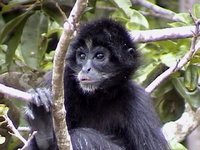Spider monkey
|
|
- This article is about an animal. For the JavaScript engine, see SpiderMonkey.
| Spider monkeys | ||||||||||||
|---|---|---|---|---|---|---|---|---|---|---|---|---|
 Geoffroy's Spider Monkey | ||||||||||||
| Scientific classification | ||||||||||||
| ||||||||||||
| Species | ||||||||||||
|
Ateles paniscus |
Spider monkeys are New World monkeys of the family Atelidae, subfamily Atelinae. Found in tropical forests from southern Mexico to Brazil, spider monkeys belong to the genus Ateles; the closely related woolly spider monkeys, are in the genus Brachyteles.
As they require large tracts of undisturbed forest, spider monkeys may be considered an indicator species; the monkeys are threatened by habitat destruction through continued growth in South American agriculture.
| Contents |
Physical description
Disproportionately long, spindly limbs inspired the spider monkey's common name. Their deftly prehensile tails, which may measure up to 89 centimetres, have highly flexible hairless tips complete with skin grooves; this adaptation to the spider monkey's strictly arboreal lifestyle grants the monkeys a fifth hand of sorts. Adults reach an average body length of 20 centimetres and a weight of 6.4 kilograms.
Spider monkeys have hook-like, narrow and thumbless hands; the fingers are elongate and recurved. The hair is coarse, ranging in colour from a ruddy gold to brown and black; the hands and feet are usually black. Heads are small with hairless faces. An unusually long clitoris in females may be mistaken for a penis; its purpose is unclear.
There is speculation that the alleged Loys's Ape is actually a large spider monkey, but this is still a matter of intense debate amongst cryptozoologists
Behaviour and reproduction
AtelesGeoffroyi.jpg
Forming loose groups of 15-25 individuals, spider monkeys are highly agile; they are said to be second only to the gibbons in this respect. Spider monkey groups are further broken down into smaller subgroups of 2-8 individuals; this is unusual as such a social structure is found in only one other primate, the chimpanzee. The strongest social bonds are formed between females and their offspring. It is also the adult females who disperse to join new groups; the males tend to stick together, forming alliances. Subgroups are generally independent and avoid each other, but hostile interactions do occur.
Spider monkeys are diurnal and spend the night in carefully selected sleeping trees. Groups are thought to be directed by a lead female who is responsible for planning an efficient route for the day's feeding activities. Grooming is not as important to social interaction, due perhaps to a lack of thumbs.
Spider monkeys mate year round. The female monkey chooses a male from her group with whom to mate. Both male and female spider monkeys sniff their mates to check their readiness for copulation. This process is known as “anogenital sniffing.” On average, only one offspring is produced from each female. The gestation period for spider monkeys ranges from 226 to 232 days.
For the first four months of life, baby spider monkeys cling to their mother's belly. Soon after, they climb to her back, eventually developing enough independence to travel on their own. Male spider monkeys have nothing to do with the raising of offspring.
At 107 grams, the spider monkey brain is twice the size of a howler monkey's of equivalent body size; this is thought to be a result of the spider monkeys' complex social system as well as their diet, which consists primarily of ripe fruit from a wide variety (over 150 species) of plants. The slow rate of development in spider monkeys may also play a role, females giving birth once every 3-4 years. Spider monkeys may live for 20 years or more.
Classification
- Family Atelidae
- Subfamily Alouattinae
- Subfamily Atelinae
- Genus Ateles
- Red-faced Spider Monkey, Ateles paniscus
- White-fronted Spider Monkey, Ateles belzebuth
- Peruvian Spider Monkey, Ateles chamek
- Brown Spider Monkey, Ateles hybridus
- White-cheeked Spider Monkey, Ateles marginatus
- Black-headed Spider Monkey, Ateles fusciceps
- Ateles fusciceps fusciceps
- Ateles fusciceps rufiventris
- Geoffroy's Spider Monkey, Ateles geoffroyi
- Ateles geoffroyi yucatanensis
- Ateles geoffroyi vellerosus
- Ateles geoffroyi geoffroyi
- Ateles geoffroyi ornatus
- Ateles geoffroyi grisescens
- Genus Brachyteles
- Genus Lagothrix
- Genus Oreonax
- Genus Ateles
External link
- The Spider Monkey Project at Punta Laguna (http://www.sas.upenn.edu/~ramosfer/spmkpl.html)de:Klammeraffen
